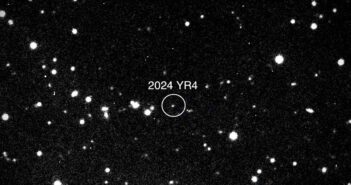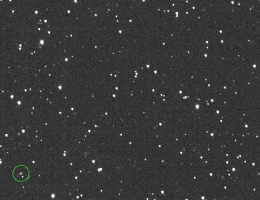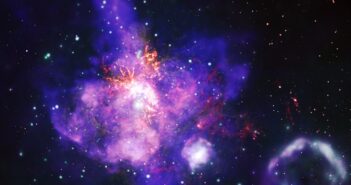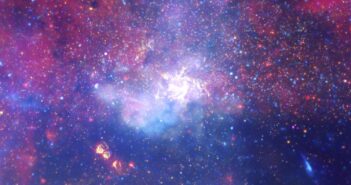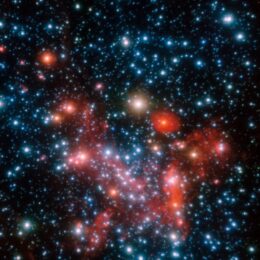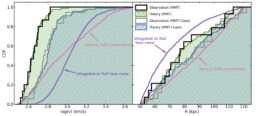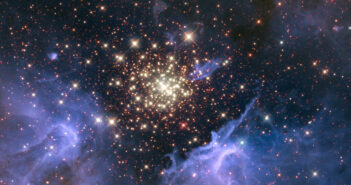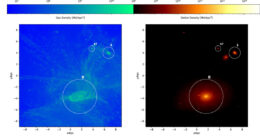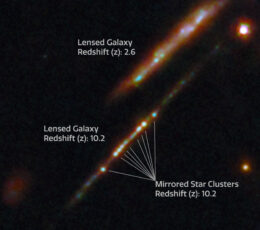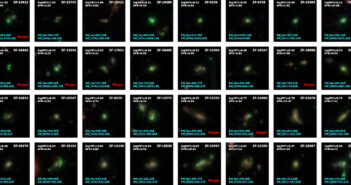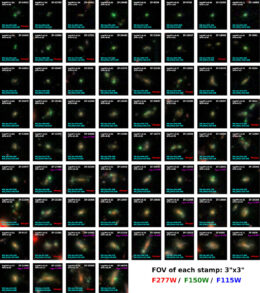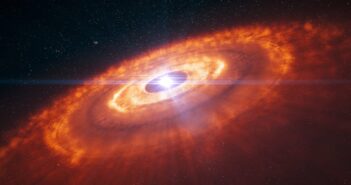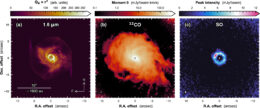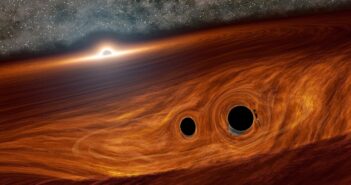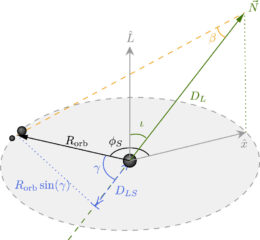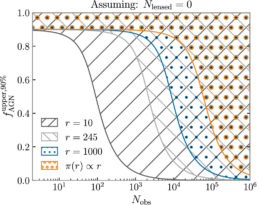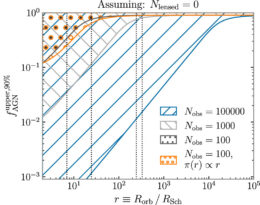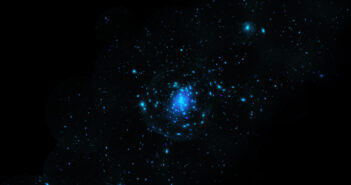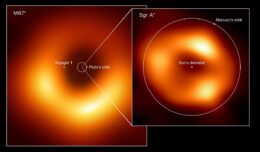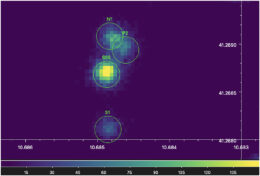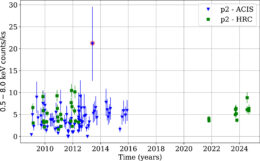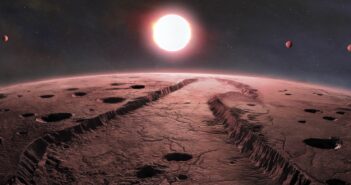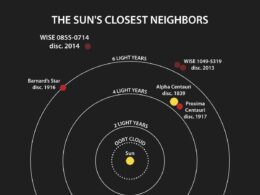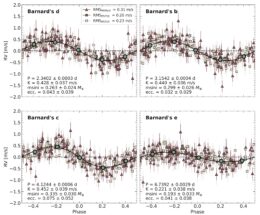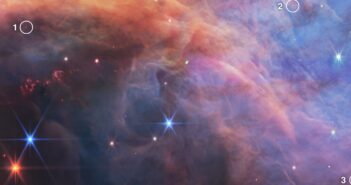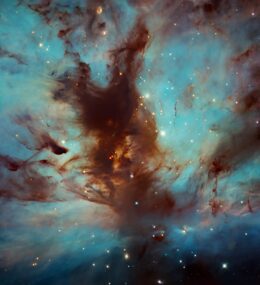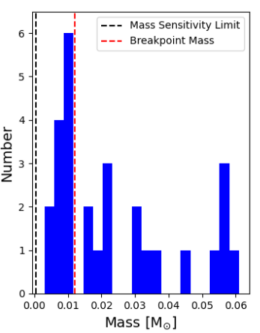This Monthly Roundup covers three investigations of the high-energy universe, from a hunt for a cosmic particle accelerator in the Milky Way to an examination of a fading quasar in the distant past.
Investigating the Most Energetic Neutrino Ever Detected
In February 2023, the Cubic Kilometre Neutrino Telescope (KM3NeT) — a neutrino telescope at the bottom of the Mediterranean Sea — detected a particle called a muon with an energy of roughly 100 petaelectronvolts (a hundred quadrillion electronvolts). The muon was likely produced by an incoming neutrino with an energy of 220 petaelectronvolts — the highest-energy neutrino ever observed.
The orientation of the event suggests an astrophysical origin, but the source of this neutrino is unknown. One possibility is that the neutrino arose in a transient event that produced extremely high-energy cosmic rays: relativistic charged particles like protons, electrons, and atomic nuclei. Cosmic rays could produce neutrinos and gamma rays through interactions with photons of the cosmic microwave background. The neutrinos zip off into space, unhindered by intervening gas or magnetic fields, while the cosmic rays can be waylaid for thousands of years, caught up in the magnetic fields that lace the space between galaxies. Gamma rays fall in between the two extremes, slowed slightly by interactions with the photons of the extragalactic background. Repeated interactions between the gamma rays and background photons create a cascade of gamma rays across a range of energies.
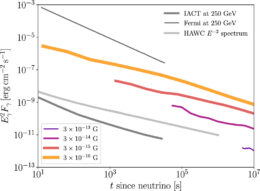
Gamma-ray flux as a function of time since the neutrino’s arrival for different intergalactic magnetic field strengths. Stronger magnetic fields lead to lower flux and later arrival times. The gray lines show the five-sigma detection limits of different instruments. Click to enlarge. [Fang et al. 2025]
Detecting this gamma-ray cascade would provide a valuable clue in the search for the origin of the ultra-high-energy neutrino detected in 2023. In a recent research article,
Ke Fang (Wisconsin IceCube Particle Astrophysics Center) and collaborators estimated the flux of gamma rays that would be associated with this high-energy neutrino. The team’s estimates accounted for varying distances to the source as well as different strengths of the intergalactic magnetic field. The stronger the magnetic field, the weaker the gamma-ray flux when it arrives at Earth, and the later the arrival time at Earth.
For weak magnetic fields, the gamma-ray cascade should have arrived at Earth hours or days after the neutrino was detected in 2023. These gamma rays are potentially detectable as long as the magnetic field is weaker than 3 × 10-13 Gauss. For magnetic field strengths greater than 3 × 10-13 Gauss, the gamma rays wouldn’t arrive until more than a decade later, and they would likely be too faint to detect. If no gamma rays are detected, the non-detection could be used to place a lower limit on the strength of the intergalactic magnetic field.
The Hunt for a Galactic PeVatron
Across the universe, charged particles are being accelerated to near the speed of light, achieving energies in the petaelectronvolt, or PeV, range. The sources of these particles are called PeVatrons, and observations have revealed that these cosmic particle accelerators exist in the Milky Way. Supernovae, massive stars, pulsars, and pulsar wind nebulae are all candidate PeVatrons. To find out more, astronomers look to gamma rays, which can be produced when cosmic rays interact with dense matter.
Recently, the Large High Altitude Air Shower Observatory (LHAASO) collaboration investigated a possible galactic PeVatron called G35.6−0.4. G35.6−0.4 is a radio source that is thought to be associated with the gamma-ray source HESS J1858+020. Observations of this region show a supernova remnant and an H II region containing multiple X-ray point sources.
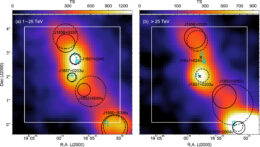
LHAASO’s Water Cherenkov Detector Array (left) and Kilometer Square Array (right) observations of the region around the gamma-ray source HESS J1858+020. Black solid circles and black crosses represent extended and pointlike sources, respectively, resolved in this work. Dashed circles show sources resolved by LHAASO in previous work. The cyan symbols show the locations of gamma-ray sources identified by other facilities. Click to enlarge. [LHAASO Collaboration 2025]
To learn more about the origins of the gamma rays from this complex region, the collaboration used data from LHAASO, a ground-based gamma-ray and cosmic-ray observatory. Data from two of LHAASO’s detectors show five gamma-ray sources throughout the region, one of which may be associated with the previously detected gamma-ray source HESS J1858+020. The team also amassed data from other sources, pulling together a picture of the molecular and atomic gas and massive stars present in the region.
Because of the crowded nature of this area, this investigation wasn’t able to clearly point to the source of the gamma rays. The authors outlined three possible sources for the gamma rays: 1) winds from hidden massive stars or outflows from protostars within the H II region, 2) particles escaping from the supernova remnant and interacting with nearby molecular clouds, and 3) an as-yet-undetected pulsar wind nebula. While none of these scenarios is a clear front-runner, neither could any of them be ruled out (though the supernova remnant scenario faces the greatest feasibility challenges). Future searches for massive stars or pulsar wind nebulae in this region may provide further clues.
Fading Light from a Quasar at Cosmic Dawn
For the third and final article, we’re looking back into the distant past at one of the most powerful objects in the universe: a quasar. Quasars are extraordinarily luminous galactic centers in the early universe, powered by accretion of gas onto a growing black hole. Because of their extreme brightness, quasars are visible from billions of light-years away, giving researchers a glimpse into the early evolution of supermassive black holes.
Jianwei Lyu (吕建伟; University of Arizona) and collaborators investigated HSC J2239+0207, a quasar located at a redshift of z = 6.2498, when the universe was roughly 900 million years old. This redshift places the quasar near the end of the epoch of reionization, when the formation of the first stars and galaxies ionized the universe’s abundant neutral hydrogen gas. This quasar is an intriguing target because previous observations have shown that the black hole that powers it is roughly 15 times more massive than expected for the stellar mass of its host galaxy. The quasar’s accretion rate is low, indicating that the black hole may be nearing the end of its growth spurt.
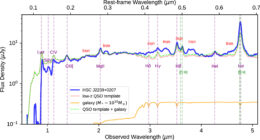
JWST spectrum of the quasar HSC J2239+0207 (blue line). Click to enlarge. [Lyu et al. 2025]
Lyu’s team analyzed JWST spectra of this quasar, estimating the black hole’s mass to be roughly 300 million solar masses (about 75 times more massive than the Milky Way’s supermassive black hole) and its accretion rate to be just 40% of the theoretical limit. This is unusual, since quasars at this point in the universe’s history typically have accretion rates at or above the theoretical limit. The unexpectedly low accretion rate for HSC J2239+0207 could mean that the black hole’s growth is slowing down. However, the authors caution that it could be a temporary slowdown caused by a lack of fuel rather than a permanent shutdown.
The team also investigated a gas cloud located one arcsecond from the quasar. This object could be several things: an isolated high-redshift galaxy, a galaxy falling toward the quasar host galaxy, tidally disrupted material stripped from a galaxy passing nearby, or material blown out of the quasar host galaxy by the quasar itself. The authors favor this final scenario, which is indicative of black hole feedback at work.
Feedback may be the reason that this black hole is so massive compared to the stellar mass of its host galaxy. Powerful radiation and winds from the black hole could have suppressed the rate of star formation as the black hole grew. With the black hole’s activity winding down, star formation should have a chance to ramp up, bringing the galaxy into alignment with the expected stellar mass–black hole mass relation.
Citation
“Cascaded Gamma-Ray Emission Associated with the KM3NeT Ultrahigh-Energy Event KM3-230213A,” Ke Fang et al 2025 ApJL 982 L16. doi:10.3847/2041-8213/adbbec
“An Enigmatic PeVatron in an Area Around H II Region G35.6−0.5,” Zhen Cao et al 2025 ApJ 979 70. doi:10.3847/1538-4357/ad991d
“Fading Light, Fierce Winds: JWST Snapshot of a Sub-Eddington Quasar at Cosmic Dawn,” Jianwei Lyu et al 2025 ApJL 981 L20. doi:10.3847/2041-8213/adb613
